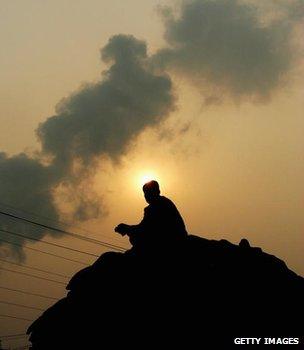UN: Rising mercury emissions increase risk to humans
- Published

Rising gold prices has seen an increase in small-scale gold mines, most of which use mercury
Developing nations are facing growing health and environmental risks from increased exposure to mercury, according to a UN report.
It says a growth in small-scale mining and coal burning are the main reasons for the rise in emissions.
As a result of rapid industrialisation, South-East Asia is the largest regional emitter and accounts for almost half of the element's annual emissions.
The findings appear ahead of a meeting that aims to cut global demand by 2015.
The Mercury: Time to Act report, external, published by the UN Environment Programme (Unep), shows that emissions from small-scale gold mining in Asia, Africa and South America have doubled since 2005.
It states: "Global emissions of mercury to the air in 2010 from human activities were estimated at 1,960 tonnes.
"Although it is difficult to compare emission estimates for individual years, total [emissions from human activities] appear to have been relatively stable from 1990 to 2010."
Globally, the demand for mercury has been steadily falling over the decades, from about 9,000 tonnes per year in the 1960s.
Shifting patterns
However, it adds that there has been a "large shift in regional patterns".

Burning coal is another major source of mercury emissions, the report says
"Economic growth has driven an increase in... emissions in southern and eastern Asia, which now accounts for about half of global emissions," the report explains.
"Emissions in Sub-Saharan Africa and South America are slowly rising, while emissions are declining in North America and Europe."
Mercury - a heavy, silvery-white metal - is a liquid at room temperature and can evaporate easily. Within the environment, it is found in cinnabar deposits. It is also found in natural forms in a range of other rocks, including limestone and coal.
Mercury can be released into the environment through a number of industrial processes including mining, metal and cement production and burning fossil fuels.
Once emitted, it persists in the environment for a long time - circulating through air, water, soil and living organisms - and can be dispersed over vast distances.
The UN says the global health burden of disease related to mercury is well recognised by governments around the world.
'Highly toxic'
The World Health Organization (WHO) says: "Mercury is highly toxic to human health, posing a particular threat to the development of the (unborn) child and early in life, external.
"The inhalation of mercury vapour can produce harmful effects on the nervous, digestive and immune systems, lungs and kidneys, and may be fatal.
"The inorganic salts of mercury are corrosive to the skin, eyes and gastrointestinal tract, and may induce kidney toxicity if ingested."
The Unep assessment says that the concentration of mercury in the top 100m of the world's oceans has doubled over the past century, and estimates that 260 tonnes of the toxic metal have made their way from soil into rivers and lakes.
Another characteristic is that mercury becomes more concentrated as it moves up the food chain, reaching its highest levels in predator fish that may be consumed by humans, the report adds.
The authors say that they expect the use of highly toxic methods will continue to grow among small-scale miners as the price for gold continues to rise.
Miners use mercury in processes that extract gold from other minerals by binding it to the element before burning it off.
Low-mercury and mercury-free methods are available, but socio-economic factors often act as barriers to miners adopting these alternative ways to extract gold, the authors add.
Although coal does not often contain high concentrations of mercury, the authors say the "combination of the large volume burned and the fact that a significant portion of the mercury present is emitted into the atmosphere results in large overall emissions from the sector".
But, they add: "The mercury content of coal varies widely, making emission estimates highly uncertain."
In 2009, nations - through the Unep Governing Council - agreed to launch negotiations to establish a legally binding treaty that would cut mercury emissions from human activities.
Next week in Geneva, government officials from more than 100 nations will begin final negotiations to establish the treaty that could lead to a reduction in global mercury demand by 2015.